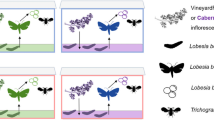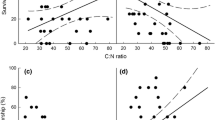Abstract
Plant species differ broadly in their responses to an elevated CO2 atmosphere, particularly in the extent of nitrogen dilution of leaf tissue. Insect herbivores are often limited by the availability of nutrients, such as nitrogen, in their host plant tissue and may therefore respond differentially on different plant species grown in CO2-enriched environments. We reared gyspy moth larvae (Lymantria dispar) in situ on seedlings of yellow birch (Betula allegheniensis) and gray birch (B. populifolia) grown in an ambient (350 ppm) or elevated (700 ppm) CO2 atmosphere to test whether larval responses in the elevated CO2 atmosphere were species-dependent. We report that female gypsy moths (Lymantria dispar) reared on gray birch (Betula populifolia) achieved similar pupal masses on plants grown at an ambient or an elevated CO2 concentration. However, on yellow birch (B. allegheniensis), female pupal mass was 38% smaller on plants in the elevated-CO2 atmosphere. Larval mortality was significantly higher on yellow birch than gray birch, but did not differ between the CO2 treatments. Relative growth rate declined more in the elevated CO2 atmosphere for larvae on yellow birch than for those on gray birch. In preference tests, larvae preferred ambient over elevated CO2-grown leaves of yellow birch, but showed no preference between gray birch leaves from the two CO2 atmospheres. This differential response of gypsy moths to their host species corresponded to a greater decline in leaf nutritional quality in the elevated CO2 atmosphere in yellow birch than in gray birch. Leaf nitrogen content of yellow birch dropped from 2.68% to 1.99% while that of gray birch leaves only declined from 3.23% to 2.63%. Meanwhile, leaf condensed tannin concentration increased from 8.92% to 11.45% in yellow birch leaves while gray birch leaves only increased from 10.72% to 12.34%. Thus the declines in larval performance in a future atmosphere may be substantial and host-species-specific.
Similar content being viewed by others
References
Arnone JA III, Zaller JG, Ziegler C, Zandt H, Korner C (1995) Leaf quality and insect herbivory in model tropical plant communities after long-term exposure to elevated atmospheric CO2. Oecologia 104:72–78
Barbosa P, Greenblatt J, Whithers W, Cranshaw W, Harrington EA (1979) Host-plant preferences and their induction in larvae of the gypsy moth, Lymantria dispar. Entomol Exp Appl 26:180–188
Basset Y (1991) Influence of leaf traits on the spatial distribution of insect herbivores associated with an overstorey rainforest tree. Oecologia 87:388–393
Bazzaz FA (1990) The response of natural ecosystems to the rising global CO2 levels. Annu Rev Ecol Syst 21:167–96
Bazzaz FA, Fajer ED (1992) Plant life in a CO2-rich world. Sci Am 266:68–74
Bazzaz FA, McConnaughay KDM (1992) Plant-plant interactions in elevated CO2 environments. Aust J Bot 40:547–563
Bell RA, Owens CD, Shapiro M, Tardif JR (1981) Development of mass rearing technology. In: Doane CC, McManus ML (eds) The gypsy moth: research towards integrated pest managent (USDA Techical Bulletin 1584). USDA, Washington, pp 599–633
Bourchier RS, Nealis VG (1993) Development and growth of early-and late-instar gypsy moth (Lepidoptera: Lymantriidae) feeding on tannin supplemented diets. Environ Entomol 22:642–646
Brown KR (1991) Carbon dioxide enrichment accelerates the decline in nutrient status and relative growth rate of Populus tremuloides Michx. seedlings. Tree Physiol 8:161–173
Burns RM, Honkala BH (1990) Silvics of North America, vol 2. Hardwoods. USDA, Washington
Coleman JS, Bazzaz FA (1992) Effects of CO2 and temperature on growth and resource use of co-occuring C3 and C4 annuals. Ecology 73:1244–1259
Coleman JS, Rochefort L, Bazzaz FA, Woodward FI (1991) Atmospheric CO2, plant nitrogen status and the susceptability of plants to an acute increase in temperature. Plant Cell Environ 14:667–674
Curtis PD, Drake BG, Whigham DF (1989) Nitrogen and carbon dynamics in C3 and C4 estuarine marsh plants grown under elevated CO2 in situ. Oecologia 78:297–301
Eamus D, Jarvis PG (1989) The direct effects of increase in the global atmospheric CO2 concentration on natural and commercial temperate trees and forests. Adv Ecol Res 19:1–55
Fajer ED (1989) The effects of enriched CO2 atmospheres on plant-insect herbivore interactions: growth responses of larvae of the specialist butterfly Junonia coenia (Lepidoptera: Nymphalidae). Oecologia 81:514–520
Fajer ED, Bowers MD, Bazzaz FA (1989) The effects of enriched carbon dioxide atmospheres on plant-insect herbivore interactions. Science 243:1198–1200
Fajer ED, Bowers MD, Bazzaz FA (1991) The effects of enriched CO2 atmospheres on the buckeye butterfly, Junonia coenia. Ecology 72:751–754
Garbutt K, Williams WE, Bazzaz FA (1990) Analysis of the differential response of five annuals to elevated CO2 during growth. Ecology 71:1185–1194
Hemming JDC, Lindroth RL (1995) Intraspecific variation in aspen phytochemistry: effects on performance of gypsy moths and forest tent caterpillars. Oecologia 103:79–88
Hough JA, Pimentel D (1978) Influence of host foliage on developement, survival and fecundity of the gypsy moth. Environ Entomol 7:97–102
Houghton RA (1990) The future role of tropical forests in affecting the carbon dioxide concentration of the atmosphere. Ambio 19:204–209
Johnson RH, Lincoln DE (1990) Sagebrush and grasshopper responses to atmospheric carbon dioxide concentration. Oecologia 84:103–110
Johnson RH, Lincoln DE (1991) Sagebrush carbon allocation patterns and grasshopper nutrition: the influence of CO2 enrichment and soil mineral limitation. Oecologia 87:127–134
Kimmerer TW, Potter DA (1987) Nutritional quality of specific leaf tissues and selective feeding by a specialist leafminer. Oecologia 71:548–551
Kuehny JS, Peet MM, Nelson PV, Willits DH (1991) Nutrient dilution by starch in CO2-enriched Chrysanthemum. J Exp Bot 42:711–716
Larigauderie A, Hilbert DW, Oechel WC (1988) Effects of CO2 enrichment and nitrogen availability on resource acquisition and resource allocation in a grass, Bromus mollis. Oecologia 77:544–549
Liebhold AM, Simons EE, Sior A, Unger JD (1993) Forecasting defoliation caused by the gypsy moth from field measurements. Environ Entomol 22:26–32
Lincoln DE, Couvet D (1989) The effect of carbon supply on allocation to allelochemical and caterpillar consumption of peppermint. Oecologia 78:112–114
Lincoln DE, Sionit N, Strain BR (1984) Growth and feeding response of Pseudoplusia includens (Lepidoptera: Noctuidae) to host plants grown in controlled carbon dioxide atmospheres. Environ Entomol 13:1527–1530
Lincoln DE, Couvet D, Sionit N (1986) Responses of an insect herbivove to host plants grown in carbon dioxide enriched atmospheres. Oecologia 69:556–560
Lincoln DE, Fajer ED, Johnson RH (1993) Plant-insect herbivore interactions in elevated CO2 environments. Trends Ecol Evol 8:64–68
Lindroth RL (1996) CO2-mediated changes in tree chemistry and tree-Lepidoptera interactions. In: Koch GW, Mooney HA (eds) Carbon dioxide and terrestrial ecosystems (Physiological Ecology Series). Academic Press, San Diego, pp 105–120
Lindroth RL, Kinney KK, Platz CL (1993) Responses of forest trees to elevated atmospheric CO2: productivity, phytochemistry, and insect performance. Ecology 74:763–777
Lindroth RL, Arteel GE, Kinney KK (1995) Responses of three saturniid species to paper birch grown under enriched CO2 atmospheres. Funct Ecol 9:306–311
Mattson WJ (1980) Herbivory in relation to plant nitrogen content. Ann Rev Ecol Syst 11:119–161
Mauffette Y, Lechowicz MJ, Jobin L (1983) Host preferences of the gypsy moth, Lymantria dispar (L.), in southern Quebec. Can J For Res 13:53–60
Miller JC, Hanson PE, Kimberling DN (1991) Development of the gypsy moth (Lepidoptera: Lymantriidae) on garry oak and red alder in western North America. Environ Entomol 20:1097–1101
Minkenberg OPJM, Ottenheim JJGW (1990) Effect of leaf nitrogen content of tomato plants on preference and performance of a leafmining fly. Oecologia 83:291–298
Montgomery ME (1982) Life-cycle nitrogen budget for the gypsy moth, Lymantria dispar, reared on artificial diet. J Insect Physiol 28:437–442
Norby RJ (1987) Nodulation and nitrogenase activity in nitrogenfixing woody plants stimulated by CO2 enrichment of the atmosphere. Physiol Plant 71:77–82
Norby RJ, O'Neill EG (1991) Leaf area compensation and nutrient interactions in CO2-enriched seedlings of yellow-poplar (Liriodendron tulipifera L.). New Phytol 117:515–528
Norby RJ, O'Neill EG, Luxmoore RJ (1986) Effects of atmospheric CO2 enrichment on the growth and mineral nutrition of Quercus alba seedlings in nutrient-poor soil. Plant Physiol 82:83–89
Oberbauer SF, Sionit N, Hastings SJ, Oechel WC (1986) Effects of CO2 enrichment and nutrition on growth, photosynthesis, and nutrient concentration of Alaskan tundra plant species. Can J Bot 64:2993–2999
Osbrink WLA, Trumble JT, Wagner RE (1987) Host suitability of Phaseolus lunata for Trichoplusia ni (Lepidoptera: Noctuidae) in controlled carbon dioxide atmospheres. Environ Entomol 16:639–644
Porter LJ, Hrstich LN, Chan BG (1986) The conversion of procyanidins and prodelphinidins to cyanidin and delphinidin. Phytochemistry 25:223–230
Reavey D (1991) Do birch feeding caterpillars make the right feeding choices? Oecologia 87:257–264
Rochefort L, Bazzaz FA (1990) Growth response to elevated CO2 in seedlings of four co-occuring birch species. Can J For Res 22:1583–1587
Roth SK, Lindroth RL (1994) Effects of CO2-mediated changes in paper birch and white pine chemistry on gypsy moth performance. Oecologia 98:133–138
Scriber JM, Slansky J Jr (1981) The nutritional ecology of immature insects. Annu Rev of Entomol 26:183–211
Smitley DR, Rao RP, Roden DB (1993) Role of tree trunks, foliage type, and canopy size in host selection by Lymantria dispar (Lepidoptera: Lymantriidae). Environ Entomol 22:134–140
Snedecor GW, Cochran WG (1989) Statistical methods. Iowa State University Press, Ames
Strong DR, Lawton JH, Southwood TRE (1984) Insects on plants. Community patterns and mechanisms. Blackwell, Oxford
Thomas RB, Richter DD, Ye H, Heine PR, Strain BR (1991) Nitrogen dynamics and growth of seedlings of an N-fixing tree (Gliricidia sepium (Jacq.) Walp.) exposed to elevated atmospheric carbon dioxide. Oecologia 88:415–421
Williams WE, Garbutt K, Bazzaz FA (1988) The response of plants to elevated CO2. V. Performance of an assemblage of serpentine grassland herbs. Environ Exp Bot 28:123–130
Wong SC (1979) Elevated atmospheric partial pressure of CO2 and plant growth. Oecologia 44:68–74
Author information
Authors and Affiliations
Corresponding author
Rights and permissions
About this article
Cite this article
Traw, M.B., Lindroth, R.L. & Bazzaz, F.A. Decline in gypsy moth (Lymantria dispar) performance in an elevated CO2 atmosphere depends upon host plant species. Oecologia 108, 113–120 (1996). https://doi.org/10.1007/BF00333222
Received:
Accepted:
Issue Date:
DOI: https://doi.org/10.1007/BF00333222




